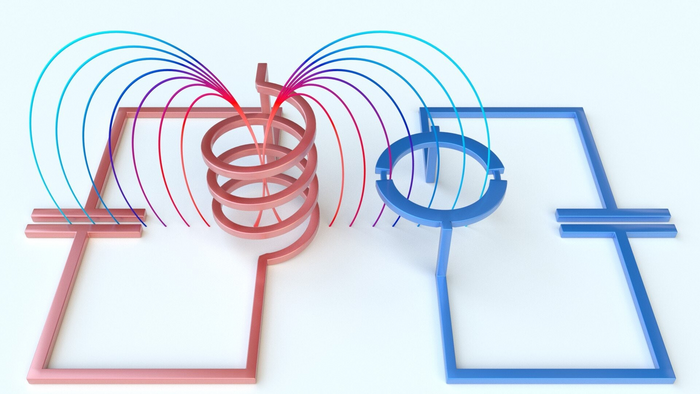A quantum scale heat pump has been built from light particles by physicists of TU Delft, ETH Zürich, and the University of Tübingen. This pump brings researchers closer to the quantum limit of quantifying radio frequency signals, which can be employed to hunt for dark matter. This research will be published in Science Advances on August 26th, 2022, as an open-access article.
 An illustration of the device, which consists of two superconducting circuits: a cold high-frequency circuit (in blue) and a hot low-frequency circuit (in red). Here, the current that flows in the red circuit generates an oscillating magnetic field which leads to the photon-pressure coupling. By sending in a strong signal to the blue high-frequency circuit, this one is transformed into an amplifier capable of detecting radio-frequency photons flowing in the red circuit with much higher sensitivity. Image credit: Researchers, Delft University of Technology.
An illustration of the device, which consists of two superconducting circuits: a cold high-frequency circuit (in blue) and a hot low-frequency circuit (in red). Here, the current that flows in the red circuit generates an oscillating magnetic field which leads to the photon-pressure coupling. By sending in a strong signal to the blue high-frequency circuit, this one is transformed into an amplifier capable of detecting radio-frequency photons flowing in the red circuit with much higher sensitivity. Image credit: Researchers, Delft University of Technology.
If two objects of varying temperature, such as a warm bottle of white wine and a cold chill pack, are brought or put together, heat generally flows in one direction—from hot (the wine) to cold (the chill pack). And after a long wait, the two objects will attain the same temperature. This process is called equilibrium in physics: a balance between the flow of heat one way and the other.
If one is willing, this balance can be broken and make the heat flow in the “wrong” way with some work. The same principle is employed in refrigerators to keep food cold and in well-functional heat pumps that can pull heat from the cold air outside to keep the house warm.
A quantum analog of a heat pump that causes the elementary quantum particles of light known as photons, to move “opposite the flow” from a hot to a cold object, is demonstrated by Gary Steele and his co-authors in their publication.
Dark Matter Signals
Currently, the researchers have managed to turn their device into an amplifier, as they had already used it as a cold bath for hot radio-frequency photons in an earlier study. Similar to amplified microwave signals released out of superconducting quantum processors, the device is more reactive to radio-frequency signals.
It’s very exciting, because we can get closer to the quantum limit of measuring the radio frequency signals, frequencies that are hard to measure otherwise. This new measuring tool might have lots of applications, one of them being to look for dark matter.
Gary Steele, Kavli Institute of Nanoscience, Delft University of Technology
A Quantum Heat Pump
The device, called a photon pressure circuit, is built from superconducting capacitors and inductors on a silicon chip that is cooled to just a few millidegrees over the temperature of absolute zero. Although this seems very cold, for certain photons in the circuit, this is a very hot temperature, and thermal energy excites them.
With the use of photon pressure, the scientists could couple these excited photons to greater frequency cold photons, which in earlier experiments enabled the cooling of hot photons into their quantum ground state.
The researchers include a new twist in this new work by passing an extra signal into the cold circuit. By doing so, they can make a motor that makes the cold photons amplified and heated up. Preferentially in one direction between the two circuits, the additional signal “pumps” the photons simultaneously.
In one part of the circuit, the researchers could cool the photons to a temperature colder than the other part by pushing photons harder in one direction than the other, making a quantum version of the heat pump for photons in a superconducting circuit.
Journal Reference:
Rodrigues, I. C., et al (2022) Parametrically enhanced interactions and nonreciprocal bath dynamics in a photon-pressure Kerr amplifier. Science Advances. doi.org/10.1126/sciadv.abq1690.